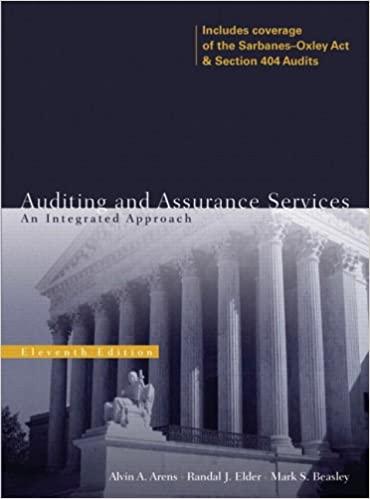Question
16:) Chuck, a single taxpayer, earns $66,000 in taxable income and $25,300 in interest from an investment in City of Heflin bonds. (Use the U.S
16:) Chuck, a single taxpayer, earns $66,000 in taxable income and $25,300 in interest from an investment in City of Heflin bonds. (Use the U.S tax rate schedule.) Required: How much federal tax will he owe? Please Explain how this was obtain and what formula you use to find it? What is his average tax rate? Please Explain how this was obtain and what formula you use to find it? What is his effective tax rate? Please Explain how this was obtain and what formula you use to find it? What is his current marginal tax rate? Please Explain how this was obtain and what formula you use to find it? If Chuck earns an additional $40,520 of taxable income, what is his marginal tax rate on this income? What is his marginal rate if, instead, he had $40,520 of additional deductions?
Or let say if Chuck, a single taxpayer, earns $79,400 in taxable income and $10,000 in interest from an investment in City of Heflin bonds. (Use the U.S. tax rate schedule.)
Required:
How much federal tax will he owe? Please Explain how this was obtain and what formula you use to find it? What is his average tax rate? Please Explain how this was obtain and what formula you use to find it? What is his effective tax rate? Please Explain how this was obtain and what formula you use to find it? What is his current marginal tax rate? Please Explain how this was obtain and what formula you use to find it?
If Chuck earns an additional $40,520 of taxable income, what is his marginal tax rate on this income? What is his marginal rate if, instead, he had $40,520 of additional deductions?
2020 Tax Rate Schedules Individuals Schedule X-Single If taxable income is over: But not over: The tax is: $ 0 $ 9,875 10% of taxable income $ 9,875 $ 40,125 $987.50 plus 12% of the excess over $9,875 $ 40,125 $ 85,525 $4,617.50 plus 22% of the excess over $40,125 $ 85,525 $163,300 $14,605.50 plus 24% of the excess over $85,525 $163,300 $207,350 $33,271.50 plus 32% of the excess over $163,300 $207,350 $518,400 $47,367.50 plus 35% of the excess over $207,350 $518,400 $156,235 plus 37% of the excess over $518,400
Schedule Y-1-Married Filing Jointly or Qualifying Widow(er) If taxable income is over: But not over: The tax is: $ 0 $ 19,750 10% of taxable income $ 19,750 $ 80,250 $1,975 plus 12% of the excess over $19,750 $ 80,250 $171,050 $9,235 plus 22% of the excess over $80,250 $171,050 $326,600 $29,211 plus 24% of the excess over $171,050 $326,600 $414,700 $66,543 plus 32% of the excess over $326,600 $414,700 $622,050 $94,735 plus 35% of the excess over $414,700 $622,050 $167,307.50 plus 37% of the excess over $622,050
Schedule Z-Head of Household If taxable income is over: But not over: The tax is: $ 0 $ 14,100 10% of taxable income $ 14,100 $ 53,700 $1,410 plus 12% of the excess over $14,100 $ 53,700 $ 85,500 $6,162 plus 22% of the excess over $53,700 $ 85,500 $163,300 $13,158 plus 24% of the excess over $85,500 $163,300 $207,350 $31,830 plus 32% of the excess over $163,300 $207,350 $518,400 $45,926 plus 35% of the excess over $207,350 $518,400 $154,793.50 plus 37% of the excess over $518,400
Schedule Y-2-Married Filing Separately If taxable income is over: But not over: The tax is: $ 0 $ 9,875 10% of taxable income $ 9,875 $ 40,125 $987.50 plus 12% of the excess over $9,875 $ 40,125 $ 85,525 $4,617.50 plus 22% of the excess over $40,125 $ 85,525 $163,300 $14,605.50 plus 24% of the excess over $85,525 $163,300 $207,350 $33,271.50 plus 32% of the excess over $163,300 $207,350 $311,025 $47,367.50 plus 35% of the excess over $207,350 $311,025 $83,653.75 plus 37% of the excess over $311,025
Step by Step Solution
There are 3 Steps involved in it
Step: 1

Get Instant Access to Expert-Tailored Solutions
See step-by-step solutions with expert insights and AI powered tools for academic success
Step: 2

Step: 3

Ace Your Homework with AI
Get the answers you need in no time with our AI-driven, step-by-step assistance
Get Started


